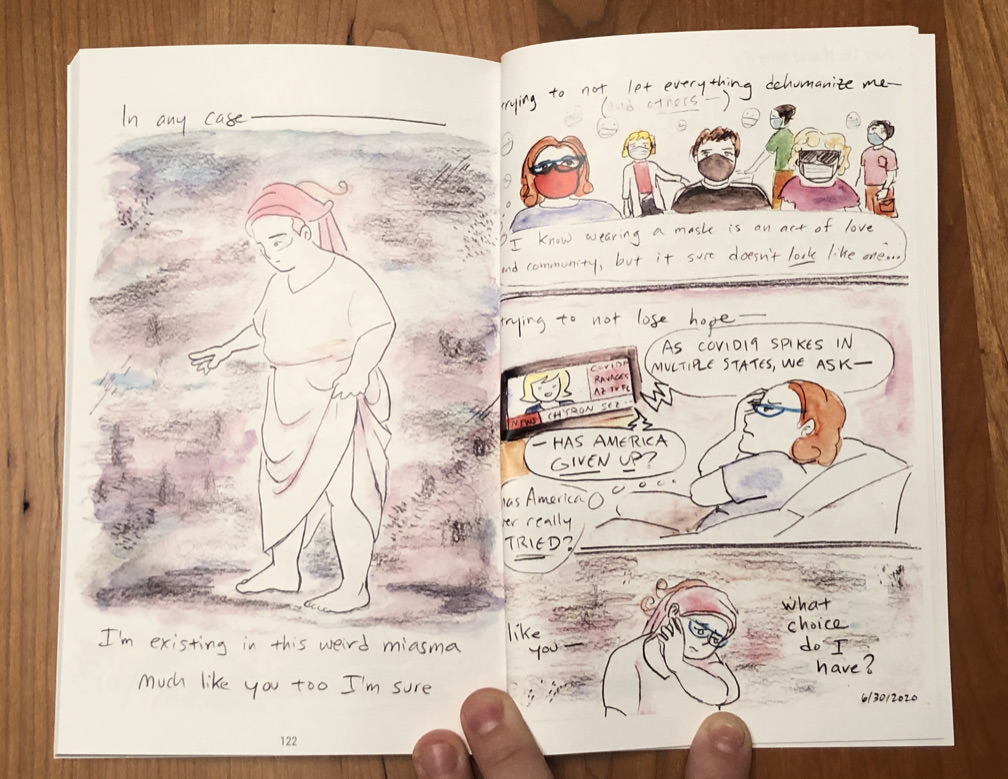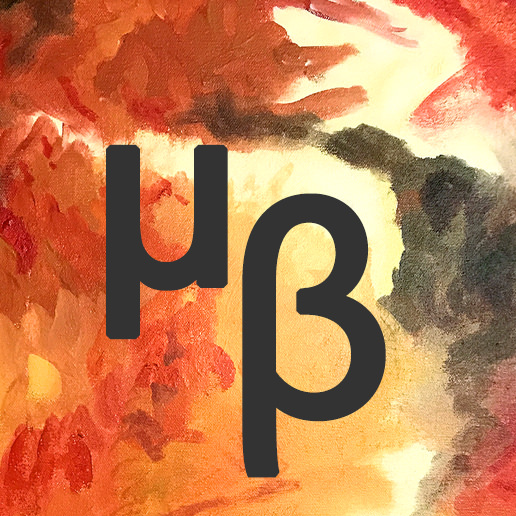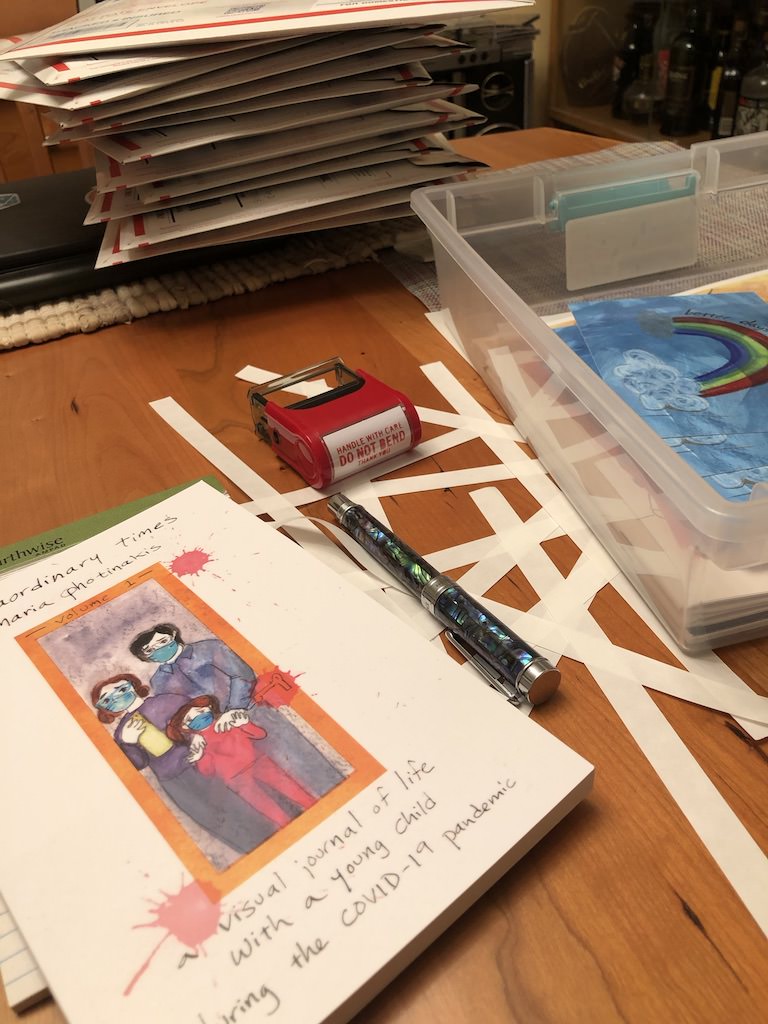Thoughts on Extraordinary Times
tags: [comics extraordinary times]
categories: reflection
Tue, Jul 20, 2021
I’ve ended my pandemic journal comic, Extraordinary Times, after working on it for a year and a half. At the end of a big project like this, I feel like some (lengthy) reflection is warranted.
How Extraordinary Times started
I started this project as simply a way to document what was going on. I have been a journaler (and later, journalist) all my life - I got my degree in journalism after all. When a big story breaks, my natural inclination is to bear witness and try to contextualize what is going on and why.
What I wanted to document specifically was the macro on a very micro level, which is basically a Journalism 101 thing about how to tell stories. I figured there would be endless commentary and archived headlines about the big global news and updates happening every day, but if I didn’t document the monumental changes it all meant for my family, then it would all be lost to time. So it was my job to document the changes and how we tried to adapt.
After I made my very first entry, on a whim I took a few bad photos of it and posted it to my Facebook profile, friends-only. I was FLOORED to read comments from friends, acquaintances, people I haven’t heard from in a long time. To them, something about my little journal really resonated, and to be honest I still don’t know why, especially since many people reading had family or home situations vastly different than mine. But I guess it’s not the artist’s job to understand how her art is received.
In any case, after that first entry, people were asking me to continue to share any entries I might make, so from that point I knew I needed to share my work as I made it. But it was also equally important for me to write for myself and not think much of audience reception, because again, I had a job to do as the family journalist. It’s impossible to completely ignore the audience but making this a me-first project allowed me to do the cursory “just get it done” art that I made, as well as update on a schedule that worked for me and no one else. Posts came daily or weekly at the outset, and slowed down to biweekly, monthly, and then bimonthly as things went on.
Why I hesitate to call it a ‘comic’
It’s a bit of semantics but it is an important one to note: I try to call Extraordinary Times a “comics visual journal” or just “visual journal” as much as I can. For the non-arts-nerds who might be reading, one of the most foundational aspects of capital-C Comics is the sequential nature: Putting the art in those boxed panels, using the panels to visually tell a story. Also, an economy of words matters — long essays with pictures are really not comics.
And yet a lot of the time that’s what I did here with Extraordinary Times. When I had the wherewithal to do more sequential-esque storytelling, using panels and dialog bubbles, I made actual comics in the pages, but for the most part I would have a bit of text with a bit of imagery. And I was definitely wordier than I like in a ‘proper’ comic.
I dunno. Perhaps this is just pedantry or semantics.
The pandemic isn’t over. Why end the journal?
While I feel some sadness that my project is done, I’m mostly relieved. Something like this — basically a diary comic — can go on without end. And this pandemic certainly at the time of this writing is nowhere near done. While I did lose steam at several points in the project, and I noted that in the journal itself as a reflection of where I was at the time, usually updating Extraordinary Times was the only kind of personal project I could find time for while also caring for my child full-time in the darkest moments of the pre-vaccine pandemic.
But once the vaccines became available here in the US, and especially once my husband and I were both fully vaccinated and we sent my daughter to school, life got a ton more manageable very fast. At that point, I knew the project would need to come to an end.
In the darkest winter months, I’d fantasize about what the end of this project would look like — maybe a jab in my arm, happy tears, throwing masks into the air, parades in the streets. But I didn’t expect the vaccine hesitancy we’ve seen, and I thought the vaccine would deliver a definitive death blow to this whole affair. Given the excruciatingly slow vaccine rollout globally, mixed with the hesitancy here at home, it’s clear SOME version of pandemic-mode life is going to be with us for a long time, sadly.
And frankly, I’m not sure I want to be constantly commenting something akin to “this SHOULD be over by now, but it’s not, and I’m furious about it” for months and months on end at this point. I wanted to move on with my life in whatever way I can, and I didn’t want to keep coming back to thinking about the pandemic in my creative space. Especially since I find myself wanting to retreat to my creative self to make escapist works now more than ever. Dwelling in the unhappy present is really not good for my mental health.
After all, even though the comics are very conceptual and roughly hewn, they do still take at least 5 hours to complete per entry. I drafted the text for each entry, mostly in brief note/outline form, and then the final pencils and artwork would happen generally extemporaneously.
What I learned from making Extraordinary Times
I tend to work fast, even before this project, but the extremely limited time I had in 2020 compressed my timelines even more. I now know very definitively what I’m capable of in just a few hours.
Flipside, the downside of working fast is perhaps that I got a bit too used to it. When things started opening up again and my daughter was able to go to school, I started getting more time to do longer pieces, I had so fallen into the habit of working in tiny chunks of time that having suddenly an hour - two hours - four or five hours - of uninterrupted time felt overwhelming and wasted on me.
That said, after more than a year of my hands making whatever came out of my head, almost immediately, I’m genuinely looking forward to slowing down and working a lot more intentionally and methodically. Extraordinary Times was so conceptual, and slowing down with upcoming projects will allow me to focus on honing technique a lot more than I could with the limited time I had in 2020.
I feel more confident that I’m really to push myself into new arenas technically. Instead of looking at it with dread of trying something hard, I’m looking forward to the challenge.
Regular updates definitely proved to me that consistent work, in whatever quality, was aiding my overall quality of work. Some of what I feel was my best work came in late summer to mid-fall 2020, when I was still updating every two weeks or so – so updating with some frequency but slowing down a little bit to linger on the page.
I never thought I’d make a project over 100 pages, let alone over 200. Extraordinary Times clocked in 276 pages in the end, plus some extras (a post-it based entry in late August 2020 when trees collapsing on my workspace kept me from working).
This project really was my lifeline through the absolute worst of this pandemic. I’m grateful for the connections it helped me make and what it taught me.
Now, on to what’s next.
You can buy Extraordinary Times in print from my online store:

Comments
I welcome your kind feedback. Thank you.
comments powered by Disqus
